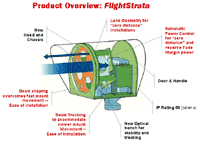Infrared LED and Laser Product Overview
The Next Generation of Wireless IR Links
Connecting high-speed LAN systems while maintaining full network speeds can be accomplished by using high-performance infrared (IR) optical LED/laser technology. Wireless infrared optical systems or FSO (free space optical) systems offer a complete series of next generation wireless line-of-sight IR communication solutions. The Flight Family of FSO systems are a result of 30 aggregate years of research and development in the field of IR communications. Using the right combination of LED/VCSEL/LASER transmit/receive boards, IR systems can be tailored to your specific speed and distance requirements.
The Technology
Free-Space Optics (FSO) is a line-of-sight technology that uses lasers to provide optical bandwidth connections. Currently, FSO is capable of up to 2.5 Gbps of data, voice and video communications through the air allowing optical connectivity without requiring fiber-optic cable or securing spectrum licenses. FSO requires light which can be focused by using either light emitting diodes (LEDs) or lasers (light amplification by stimulated emission of radiation). The use of lasers is a simple concept similar to optical transmissions using fiber-optic cables; the only difference is the medium. Light travels through air faster than it does through glass, so it is fair to classify FSO as optical communications at the speed of light.
FSO technology is relatively simple. It's based on connectivity between FSO units, each consisting of an optical transceiver with a laser transmitter and a receiver to provide full duplex (bi-directional) capability. Each FSO unit uses a high-power optical source (i.e. laser), plus a lens that transmits light through the atmosphere to another lens receiving the information. The receiving lens connects to a high-sensitivity receiver via optical fiber. FSO technology requires no spectrum licensing. FSO is easily upgradeable and its open interfaces support equipment from a variety of vendors which helps service providers protect their investment in embedded telecommunications infrastructures.
 FSO involves the optical transmission of voice, video, and data using air as the medium of transmission as opposed to fiber optic cable. Transmission using FSO technology is relatively simple. It involves two systems each consisting of an optical transceiver which consists of a laser transmitter and a receiver to provide full duplex (bi-directional) capability. Each FSO system uses a high-power optical source (e.g., laser ) plus a telescope that transmits light through the atmosphere to another telescope that receives the information. At that point, the receiving telescope connects to a high-sensitivity receiver through an optical fiber. Unlike radio frequencies, the technology requires no spectrum licenses. It is easily upgradeable, and its open interfaces support equipment from a variety of vendors, which helps carriers protect the investment in their embedded infrastructures.
FSO involves the optical transmission of voice, video, and data using air as the medium of transmission as opposed to fiber optic cable. Transmission using FSO technology is relatively simple. It involves two systems each consisting of an optical transceiver which consists of a laser transmitter and a receiver to provide full duplex (bi-directional) capability. Each FSO system uses a high-power optical source (e.g., laser ) plus a telescope that transmits light through the atmosphere to another telescope that receives the information. At that point, the receiving telescope connects to a high-sensitivity receiver through an optical fiber. Unlike radio frequencies, the technology requires no spectrum licenses. It is easily upgradeable, and its open interfaces support equipment from a variety of vendors, which helps carriers protect the investment in their embedded infrastructures.

